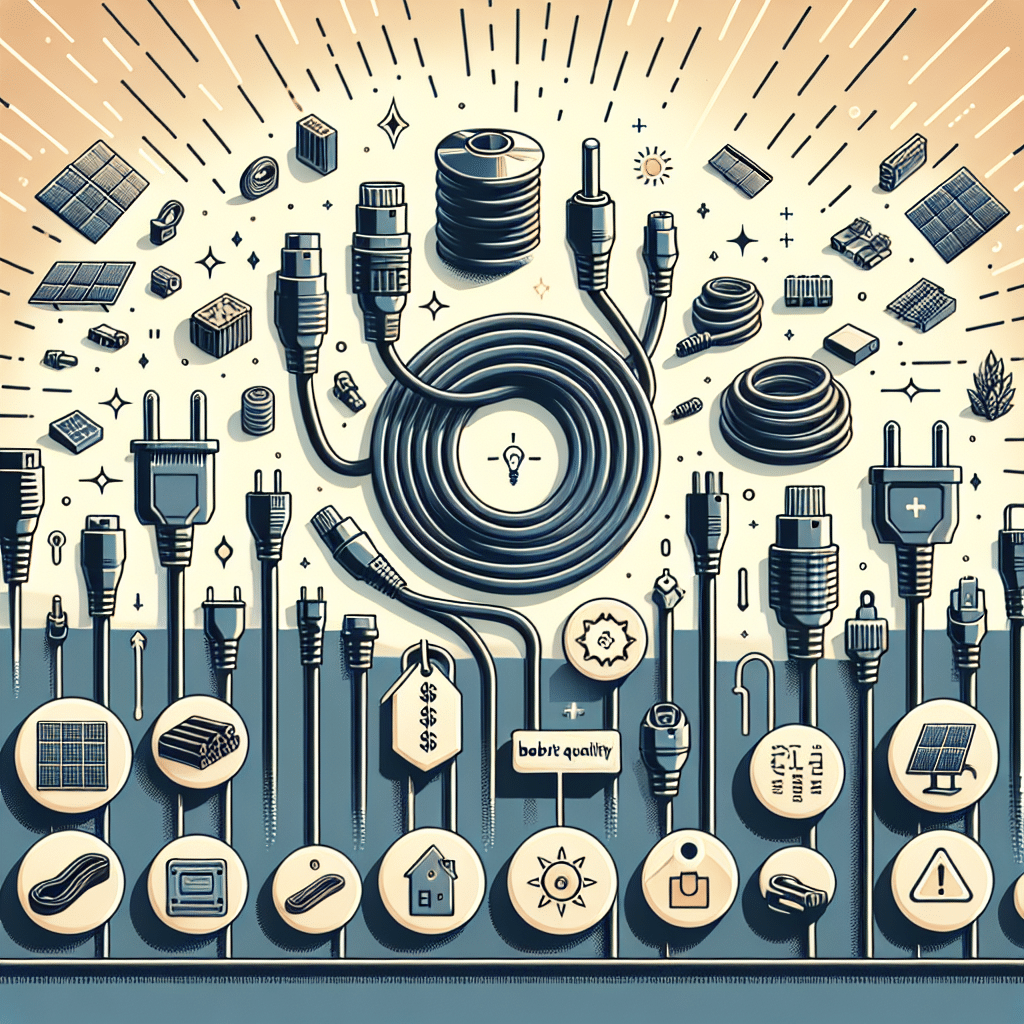Understanding Solar Cables and Connectors
Solar energy systems require a variety of components to function effectively and efficiently. Critical among these are solar cables and connectors. They play a pivotal role in the overall performance, safety, and longevity of solar power systems. This article delves into affordable solar cables and connectors, providing insights into their types, specifications, installation considerations, and procurement options.
Types of Solar Cables
-
Photovoltaic (PV) Cable:
- PV cables are specifically designed for solar panel systems. They are flexible, UV resistant, and can endure outdoor exposure and extreme temperatures. Look for cables compliant with standards like UL 4703 or IEC 62930.
-
Solar AC and DC Cables:
- DC cables carry direct current from solar panels to the inverter, while AC cables transmit alternating current from the inverter to the grid. Both play crucial roles in the solar power generation system.
-
Data Cables:
- For solar monitoring systems, data cables help in communication between solar panels and monitoring equipment. Choosing the right type of data cable is crucial for achieving effective performance.
Key Specifications of Solar Cables
-
Temperature Rating:
- Solar cables should be rated to withstand a variety of temperatures without degrading. Most quality solar cables manage well in temperatures ranging from -40°C to +90°C.
-
Copper vs. Aluminum:
- Copper cables offer better conductivity and are preferred for significant installations. However, aluminum cables are lighter and more affordable, which can be advantageous for smaller systems.
-
Wire Gauge:
- The American Wire Gauge (AWG) standard measures wire diameter. Common sizes for solar applications range from 10 AWG to 14 AWG. Thicker cables (lower AWG numbers) minimize resistance but can be pricier and heavier.
-
Insulation and Sheath Material:
- Most reliable solar cables use cross-linked polyethylene (XLPE) or polyvinyl chloride (PVC). XLPE offers superior thermal performance, while PVC cables are cheaper but have a shorter lifespan.
Solar Connectors Explained
-
MC4 Connectors:
- MC4 (Multi-Contact 4mm) connectors are the industry standard for solar panels. They are reliable, easy to use, and weather-resistant, with a robust locking mechanism ensuring a secure connection.
-
T4 Connectors:
- T4 connectors are gaining popularity for their compact design and higher current-carrying capacity. They are designed for high-performance applications and are compatible with multiple cable sizes.
-
Branch Connectors:
- These connectors enable multiple solar panels to be connected to a single cable run, enhancing system efficiency and simplifying installation.
Important Installation Considerations
-
Compatibility:
- Ensure all cables and connectors are compatible both with the solar panels and with the inverter system. Manufacturers typically provide compatibility specifications.
-
Weather Resistance:
- Given that they are usually installed outdoors, solar cables and connectors must withstand harsh weather conditions. Look for products that feature UV resistant and water-resistant characteristics.
-
Heat Shrink Tubing:
- Use heat shrink tubing for additional protection at connection points. This provides a tight seal, shielding against moisture and dirt while protecting against physical damage.
Cost-effective Options for Solar Cables and Connectors
-
Retail Options:
- Local hardware stores or specialized solar equipment suppliers may offer competitive prices on bulk purchases. Always compare prices and don’t hesitate to ask for discounts on larger orders.
-
Online Marketplaces:
- Websites like Amazon, eBay, and specialized companies such as Renogy and Eco-Worthy provide a wide range of affordable solar cables and connectors. Ordering online can often be cheaper due to fewer overhead costs.
-
Manufacturer Direct Purchases:
- Direct purchases from manufacturers can lead to significant cost savings. Many companies offer bulk discount rates or promotional events.
-
Local Energy Efficiency Programs:
- Many regions have grants or discounted programs aimed at promoting solar energy adoption. Research local incentives that may help offset installation costs.
Quality Assurance and Certification Standards
-
Certification Labels:
- Look for products that meet international standards like UL, IEC, and ISO certifications. These ensure that the cables and connectors have gone through rigorous testing for safety and performance.
-
Warranty Information:
- A product warranty is a good indicator of quality. Reliable manufacturers often provide reasonable warranties that can range from 5 to 25 years.
-
User Reviews:
- Before making a purchase, check user reviews and ratings. A well-reviewed product can give you confidence in making the right choice for your solar setup.
Maintenance Tips for Solar Cables and Connectors
-
Regular Inspection:
- Regularly inspect all connections and cable routes for signs of wear, corrosion, or physical damage. Early detection can prolong the system’s life.
-
Cleaning:
- Keep connectors clean from dirt and moisture. A dirty or corroded connector can lead to voltage drops and reduced system efficiency.
-
Temperature Monitoring:
- Pay attention to the operating temperature of cables. If cables feel excessively hot to the touch, it may indicate an issue that needs addressing.
Conclusion
Affordable solar cables and connectors are vital for the effective functioning of solar power systems. By understanding the types, specifications, and options available, one can make informed decisions that combine cost-effectiveness with quality and safety. With the proper knowledge, solar installation becomes less daunting and more accessible, contributing to a greater adoption of renewable energy sources.
